Canada's Hero
By Hervé St.Louis
June 11, 2006 - 10:37
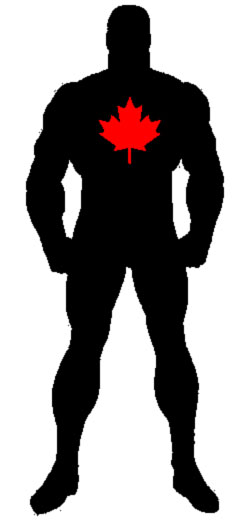 |
Becoming an icon of American culture Superman inspired the first wave of super heroes who appeared during World War Two and often fought evil Nazi saboteurs. As Canada had joined the war efforts before the United States, the same promotional effort used to prop up support for the war effort and troops sent overseas appeared In Canada. But most revealing of all the main inspiration for Canadian super heroes were the lack of American material being delivered to Canada because of paper restrictions by the government.
The Golden Age
To fill this void, several super heroes came forth, published by several companies. In the United States, patriotic heroes had come of age already. The first the Shield was created by Jewish cartoonist Jack Kirby. Kirby would also lend his hand to the Captain America, the best known patriotic super hero outside of Superman and Wonder Woman. But Canada had no defining feature at this point in history. Canada still used the British Union Jack as its main flag. Therefore there were no dominating cultural artifacts upon which to create a national super hero.
Yet the first Canadian flag bearers sported the name Nelvana, Canada Jack, Johnny Canuck and Sergeant Canuck. Of course, there were other World War Two heroes but each of these characters, unlike the other ones who could have easily been standard American heroes were consciously Canadian.
 |
| Nelvana |
Johnny Canuck, first published in 1942 in Dime Comics # 1was an areal jock with super strength whose main job was fighting the Nazis. At the time Canada’s Royal Air force was active in the war efforts and could be seen as a new ideal to aspire to by young Canadian boys. Published by a Toronto publisher, from the beginning Johnny Canuck was known as "Canada’s super hero."
Always competing with Toronto, Montreal too had to come up with their own Canadian hero. Canada Jack was created by Montreal cartoonist George Rae and published by Education Project, a publisher who had no experimented with super heroes before Canada Jack and the anthology he appeared in Canadian Heroes # 5, published in 1943. Besides being a gymnast with super strength and knowledge of martial arts, he was also a good horseback rider.
Now, how many American contemporary super heroes are good horseback riders? Well, there’s the Vigilante, and the Shining Knight but both of them appear often with horse or in contextual situations where horseback riding is normal. In the Canadian context, good horseback riding is a skill if one understands that being a member of the Royal Mounted Police was one of the things little boys often dreamed of. Perhaps that’s where Sergeant Canuck drew his inspiration from.
The Silver Age?
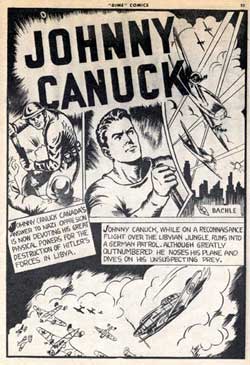 |
| Johnny Canuck |
However the 1970s was also the age of independent comic book creation and this effervescence had also gained Canada. The 1970s had been trying years for Canada’s favourite past time, national unity. The above-mentioned Canadian heroes had never crossed the cultural divide of French and English solitudes. The Province of Quebec even had its own hero in the form of Capitaine Kébec, a hippie who smoked drugs and was super strong.
Capitaine Kébec was not alone in the comedy side of comic books. Captain Canada I arrived in 1972 first on the radio and later in a comic strip published in Fuddle Duddle # 4. Of course he had a sidekick called Beaver Boy, after one of Canada’s national animal.
Northern Light who appeared in Orb # 2 in 1974, was an architect who shuns modern architecture. Captured by aliens in the wilderness, he is given his current powers allowing him to manipulate light sources - and of course, be super strong! The theme of the nature crawled back into the Canadian psyche. But this time, he would work for a secret Canadian government agency, like much of Alpha Flight would do later.
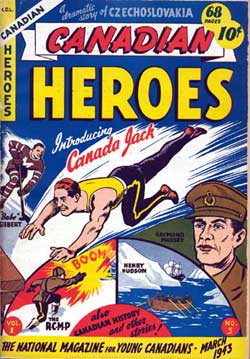 |
| Canada Jack |
However, the word “Canuck” is nothing but a shorthand for Canada or Canadian. Therefore, the stage was clear for Canada to get its official Captain Canada II in 1981 as part of Captain Newfoundland comic book series. Appearing in the first issue, he of course, could fly as well as control electromagnetic fields.
The American Canadian
By far the best known major Canadian super hero representative of the country would come from an American comic book and be published in a series for over a decade and earn himself action figures and several appearances in a cartoon series. The character was at first called Vindicator. Like many before and after him, he sported the traditional Canadian flag colours. However, unlike most of them, he would be marketed first to American readers.
Vindicator appeared in X-Men #109 in 1978 as Weapon Alpha, an agent of the Canadian Government whose objective was to bring back the Canadian X-Men called Wolverine. Vindicator, returned later with other Canadian heroes, representing all regions of the country. In a sense, the entire team collectively represented all of Canada. Their powers drew on the various cultures from Canada.
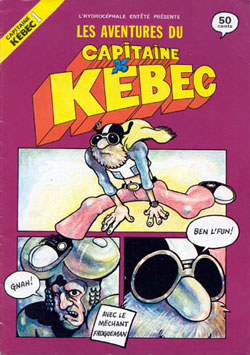 |
| Capitaine K�bec |
Marina was an amphibian from the Atlantic province of Newfoundland. She was close to the sea, like most people in that area. Sasquatch evoked mythical creatures from the Canadian wilderness, but with a scientific twist. He also was from British Columbia. The representative from the first nations, Shaman was from the Western province of Alberta, while Snowbird, represented the Inuit Gods from Northern Canada.
National Super Heroes
Canada does not have the exclusivity on patriotic heroes. In the United States, there is an entire sub genre of patriotic super heroes. Other nations have super heroes that look like them. Often these national or ethnic heroes are created to supercede American imports.
In a nation like Canada, this is very important. The Canadian comic book industry is indistinguishable from the American one. In fact Canada probably prints more comic books than the United States, as most North American are printed in Montreal, Quebec.
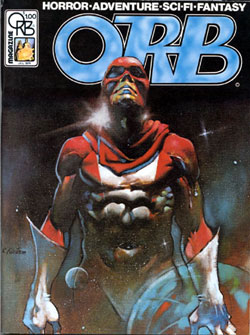 |
| Northern Light |
In Canada, there are no geographic barriers to American products. Because there are no government quotas, there are no protections for Canadian-made products like other cultural industries. That means that Canadians have had to rely on nothing but their skills and tenacity to produce comic books. In fact, this quest for survival has repeatedly produced the most popular creations in the North American market. Starting with Superman, Canadians have also contributed Spawn and Cerebus
National Unity
The need to create national heroes representing Canada is always difficult because of Canada’s diversity. Any hero will by default stand mostly for the English Canadians majority and not for Canadians from Quebec. The solution often adopted to solve the Quebec representation issue is to provide the main hero with a French Canadian sidekick or associate. For example, Captain Canada II had an ally called Mademoiselle. Captain Canuck had Kébec, a secret agent who went on many missions with him. Northguard had Fleur de Lys, a martial arts’ expert.
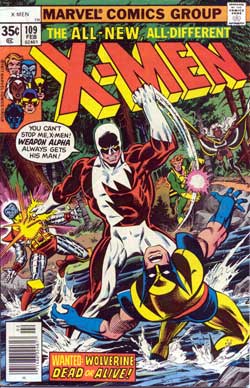 |
| Guardian (aka Vindicator) |
Canada’s Title
With so many Canadian flag bearers, it is difficult to assess which one is the most important or should be hailed as the Canadian hero of choice. Newer contestants such as Canadiana, appearing in a Web comic, also aspire to Canada’s throne. All these characters seek to be Canada’s hero by using the guise of the American super hero, which ironically was co-created by Canadians.
Do Canadians even need national heroes? One of the problems with finding a main Canadian flag bearer is the spotty publishing history of all these characters. None of the Golden Age greats have reappeared or being upgraded, while modern counterparts have trouble staying in print for long. These modern comic books are often published by smaller publishers in American distribution channels. It is hoped that from such limited exposure, Canadian might become significantly interested in them.
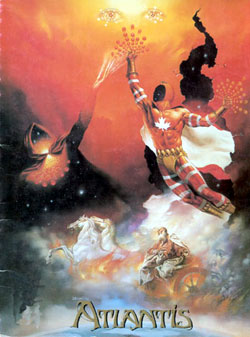 |
| Captain Canada |
The case for Guardian and Vindicator is strong. Visually, their costume is more stunning than the classic Northguard, Captain Canuck or Captain Canada apparel. Canadian artist John Byrne used negative space and asymmetric designs making them distinctive and memorable. Visual design quality is very important when creating icons. Both Guardian and Vindicator have had mass-produced action figures created and sold in the past. Commercially, they are on safer ground than all their competitors.
If we use total dollars earned, then Wolverine would be the main Canadian super hero. However, as proud as Wolverine is about his Canadian heritage, he is not a flag bearer. It would be like making Batman the national icon of patriotic super heroes in the United States.
Canada’s Real Champion
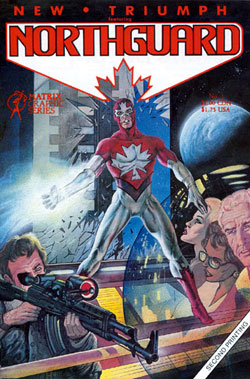 |
| Northguard |
This unique character is none other than Alpha Flight’s Sasquatch. Yes, Sasquatch, the big foot who has been a part of Alpha Flight and the comic boom world since X-Men #120, published in 1979. Sasquatch is Canadian, but has no need of a sidekick to represent the French factor of Canada. His powers are based on mythical creatures emerging out of Canadians folklore across the country.
In the West, they call him Sasquatch. In Quebec and Northern Ontario, they Call him Wendigo. In Central Canada and the Atlantic, they call him Big Foot. Canadians of all walks of life claim to have seen such creatures in the real life. At first, based on native folk tales, stories of sasquatches have spread all over Canada. Visually Sasquatch is unique. No other comic book character is quite like him.
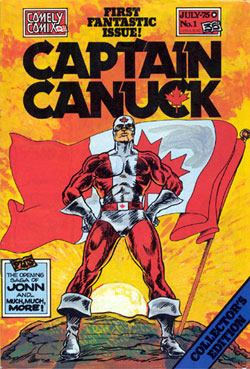 |
| Captain Canuck |
Sasquatch developed his powers as a mean to study what had caused Bruce Banner to turn into the Hulk. For many, Sasquatch was a junior version of the incredible Hulk, but more refined and less aggressive. Sasquatch even was a Canadian expatriate who played for the Green Bay Packers, from the NFL, instead of Canada’s Football League. This is all typical behaviour for Canadians always trying to measure up to their American cousins.
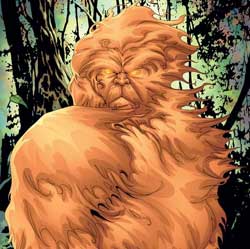 |
| Sasquatch |
Sources:
http://www.collectionscanada.ca/superheroes/
http://www.internationalhero.co.uk/
Notes:
For more extensive coverage on Canadian super heroes, The Collection Canada has the most authoritative information. It is a government agency whose mandate is to archive Canadian documents.
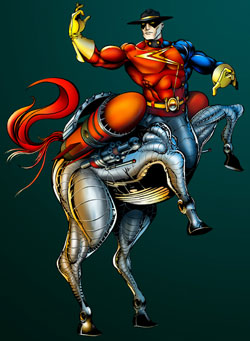 |
| Captain Stallion |
This article did not cover other characters like Stallion Canuck and Canadiana very much because there aren’t many appearances outside of the Internet.
We also omitted to talk about Brian Tobin, the best known of the three Captain Canada, who is a real man, former Minister in the 1990s Federal Liberals and later Premier of the Province of Newfoundland. He earned the nickname Captain Canada after the 1995 Turbot War. It was a dispute which pitted Canada against Spain and the European Union over fisheries quotas in international waters, next to Canada.
Related Articles:
That Time Canada Claimed Superman for Stamps Collectors
VIZ Media and Eleven Arts Debut "Boruto: Naruto the Movie" in Canada
VIZ Media Announces Naruto in Canada
Fan Expo Canada 2012- RE Holmes Creative Communications
2011 Fan Expo Canada Reveals Powerhouse Lineup of Comic Guests
Conservative Harper's Majority Starts Exodus from Canada
Fan Expo Canada Adds Fourth Day
2010 Fan expo Canada Media Advisory
Fan Expo Canada 2009 Update
Does Canada Need a Master Cartoonist Like Doug Wright?
